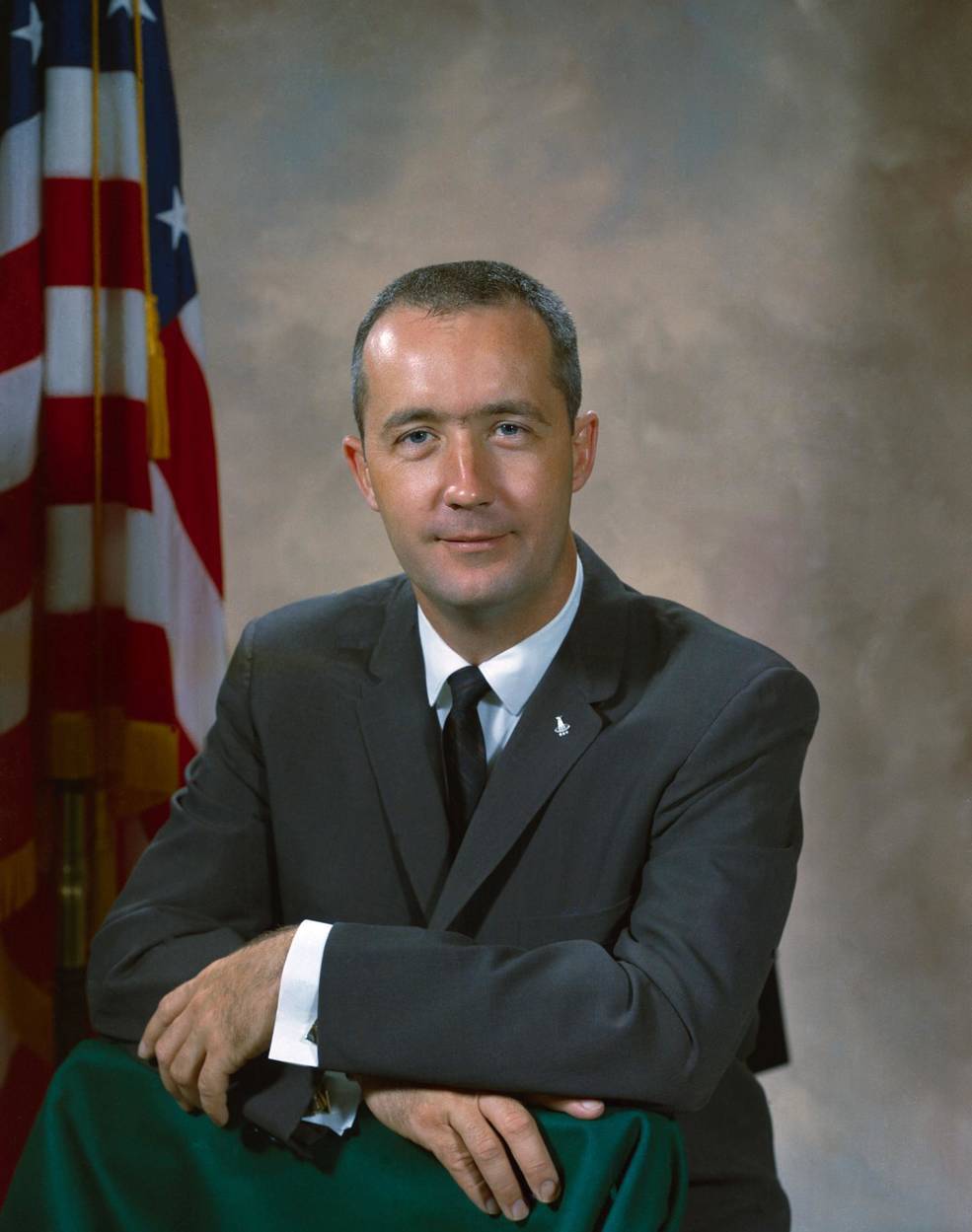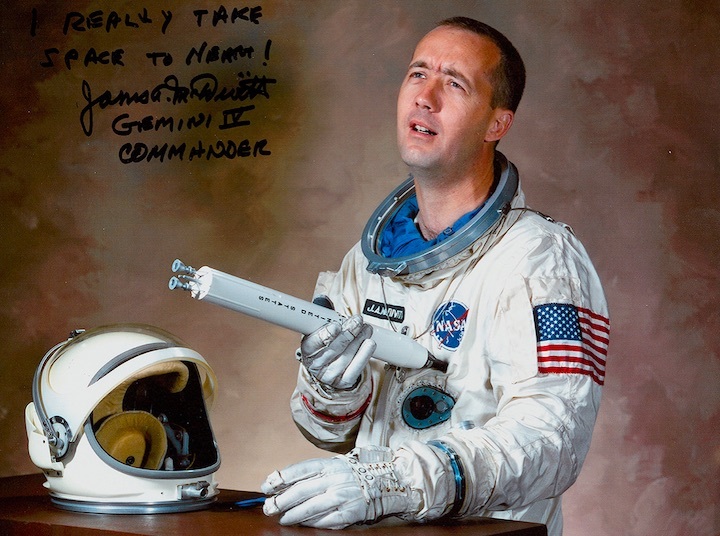21.10.2022

Correction: This news release was updated on Oct. 17, 2022 to remove the erroneous reference in the first sentence about Apollo 9 flying around the Moon.
Former NASA astronaut James A. McDivitt, who commanded the Gemini IV and Apollo 9 missions, died Oct. 13. McDivitt passed away peacefully in his sleep surrounded by his family and friends in Tucson, Arizona. He was 93 years old.
McDivitt was born June 10, 1929, in Chicago. He graduated from Kalamazoo Central High School, in Kalamazoo, Michigan, before going on to receive a Bachelor of Science degree in Aeronautical Engineering from the University of Michigan, graduating first in his class in 1959.
He joined the Air Force in 1951 and retired with the rank of Brig. General. He flew 145 combat missions during the Korean War in F-80 and F-86 aircraft. He was a graduate of the U.S. Air Force Experimental Test Pilot School and the U.S. Air Force Aerospace Research Pilot course and served as an experimental test pilot at Edwards Air Force Base, California. He logged more than 5,000 flying hours during his piloting career.
McDivitt was selected as an astronaut by NASA in September 1962 as part of NASA's second astronaut class.
He first flew in space as commander of the Gemini IV mission in June 1965. McDivitt was joined by fellow Air Force pilot Ed White on the program’s most ambitious flight to date. During Gemini IV, White would become the first American to venture outside his spacecraft for what officially is known as an extravehicular activity (EVA) or as the world has come to know it, a spacewalk. In the following years, it was a skill that allowed Apollo explorers to walk on the Moon and American astronauts and their partners from around the world to build the International Space Station. The mission’s four-day duration nearly doubled NASA astronauts’ previous time in space to that point, with the longest American spaceflight previously being Gordon Cooper’s 34-hour Mercury 9 mission.
McDivitt’s second spaceflight as the commander of Apollo 9 played a critical role in landing the first humans on the Moon. This was the first flight of the complete set of Apollo hardware and was the first flight of the Lunar Module. The mission launched from NASA’s Kennedy Space Center on March 3, 1969, with Commander James McDivitt, Command Module Pilot David Scott, and Lunar Module Pilot Russell Schweickart. After launch, Apollo 9 entered Earth orbit and the crew performed an engineering test of the first crewed lunar module, nicknamed “Spider,” from beginning to end. They simulated the maneuvers that would be performed during actual lunar missions. During the mission, the astronauts performed a series of flight tasks with the command and service module and the lunar module. The top priority was rendezvous and docking of the lunar module with the command and service module. The crew also configured the lunar module to support a spacewalk by McDivitt and Schweickart. On Flight Day 10, March 13, 1969, the Apollo 9 capsule re-entered Earth’s atmosphere and splashed down in the Atlantic Ocean, within three miles and in full view of the recovery ship, the USS Guadalcanal, about 341 miles north of Puerto Rico.
McDivitt logged more than 14 days in space.
After Apollo 9, he became manager of lunar landing operations, and led a team that planned the lunar exploration program and redesigned the spacecraft to accomplish this task. In August 1969, he became manager of the Apollo Spacecraft Program, guiding the program through Apollo 12, 13, 14, 15 and 16.
McDivitt retired from the U.S. Air Force and left NASA in June 1972, to take the position of executive vice-president, corporate affairs for Consumers Power Company. In March 1975, he joined Pullman, Inc. as executive vice-president and a director. In October 1975 he became president of the Pullman Standard Division, The Railcar Division, and later had additional responsibility for the leasing and engineering and construction areas of the company. In January 1981 he joined Rockwell International as senior vice president, government operations, and Rockwell International Corporation, Washington, D.C.
His numerous awards included two NASA Distinguished Service Medals and the NASA Exceptional Service Medal. For his service in the U.S. Air Force, he also was awarded two Air Force Distinguished Service Medals, four Distinguished Flying Crosses, five Air Medals, and U.S. Air Force Astronaut Wings. McDivitt also received the Chong Moo Medal from South Korea, the U.S. Air Force Systems Command Aerospace Primus Award, the Arnold Air Society JFK Trophy, the Sword of Loyola, and the Michigan Wolverine Frontiersman Award.
Quelle: NASA
+++
Astronaut James McDivitt, Apollo 9 commander, dies at 93
The NASA astronaut who commanded the Apollo 9 mission has died

"I really take space to heart!" Gag photo of Jim McDivitt, Gemini 4 commander. (Heritage Auctions)
WASHINGTON -- James A. McDivitt, who commanded the Apollo 9 mission testing the first complete set of equipment to go to the moon, has died. He was 93.
McDivitt was also the commander of 1965’s Gemini 4 mission, where his best friend and colleague Ed White made the first U.S. spacewalk. His photographs of White during the spacewalk became iconic images.
He passed on a chance to land on the moon and instead became the space agency’s program manager for five Apollo missions after the Apollo 11 moon landing.
McDivitt died Thursday in Tucson, Arizona, NASA said Monday.
In his first flight in 1965, McDivitt reported seeing “something out there’’ about the shape of a beer can flying outside his Gemini spaceship. People called it a UFO and McDivitt would later joke that he became “a world-renowned UFO expert.” Years later he figured it was just a reflection of bolts in the window.
Apollo 9, which orbited Earth and didn’t go further, was one of the lesser remembered space missions of NASA’s program. In a 1999 oral history, McDivitt said it didn’t bother him that it was overlooked: “I could see why they would, you know, it didn’t land on the moon. And so it’s hardly part of Apollo. But the lunar module was ... key to the whole program.”
Flying with Apollo 9 crewmates Rusty Schweickart and David Scott, McDivitt’s mission was the first in-space test of the lightweight lunar lander, nicknamed Spider. Their goal was to see if people could live in it, if it could dock in orbit and — something that became crucial in the Apollo 13 crisis — if the lunar module’s engines could control the stack of spacecraft, which included the command module Gumdrop.
Early in training, McDivitt was not impressed with how flimsy the lunar module seemed: “I looked at Rusty and he looked at me, and we said, ‘Oh my God! We’re actually going to fly something like this?’ So it was really chintzy. ... it was like cellophane and tin foil put together with Scotch tape and staples!”
Unlike many of his fellow astronauts, McDivitt didn’t yearn to fly from childhood. He was just good at it.
McDivitt didn’t have money for college growing up in Kalamazoo, Michigan. He worked for a year before going to junior college. When he joined the Air Force at 20, soon after the Korean War broke out, he had never been on an airplane. He was accepted for pilot training before he had ever been off the ground.
“Fortunately, I liked it,” he later recalled.
McDivitt flew 145 combat missions in Korea and came back to Michigan where he graduated from the University of Michigan with an aeronautical engineering degree. He later was one of the elite test pilots at Edwards Air Force Base and became the first student in the Air Force’s Aerospace Research Pilot School. The military was working on its own later-abandoned human space missions.
In 1962, NASA chose McDivitt to be part of its second class of astronauts, often called the “New Nine,” joining Neil Armstrong, Frank Borman, Jim Lovell and others.
McDivitt was picked to command the second two-man Gemini mission, along with White. The four-day mission in 1965 circled the globe 66 times.
Apollo 9’s shakedown flight lasted 10 days in March 1969 — four months before the moon landing — and was relatively trouble free and uneventful.
“After I flew Apollo 9 it was apparent to me that I wasn’t going to be the first guy to land on the moon, which was important to me,” McDivitt recalled in 1999. “And being the second or third guy wasn’t that important to me.”
So McDivitt went into management, first of the Apollo lunar lander, then for the Houston part of the entire program.
McDivitt left NASA and the Air Force in 1972 for a series of private industry jobs, including president of the railcar division at Pullman Inc. and a senior position at aerospace firm Rockwell International. He retired from the military with the rank of brigadier general.
Quelle: abcNews

